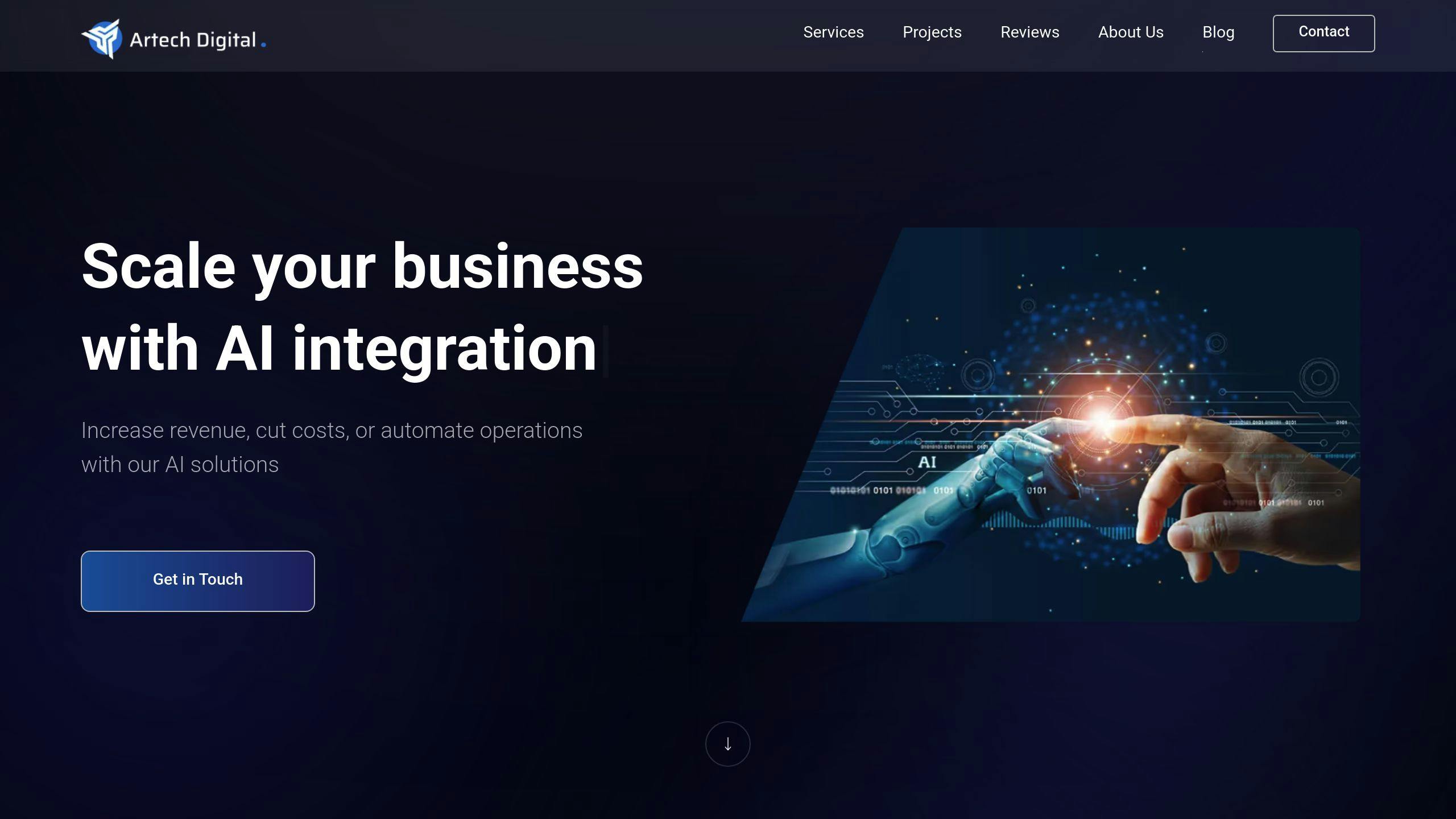
AI tech stacks are the backbone of modern AI systems, enabling businesses to process data, build models, deploy solutions, and ensure reliability. Here’s a quick breakdown of the main components and their roles:
These layers work together to create scalable and efficient AI systems. Businesses can integrate them to address challenges like data quality, scalability, and model drift while staying prepared for future trends like Edge AI and low-code platforms.
The data infrastructure layer is the backbone of any AI system. It handles the entire journey of data - from collection to processing and storage - ensuring the system operates efficiently and reliably.
Platforms like AWS S3 and Google Cloud Storage provide scalable options for managing large datasets. Depending on the type of data, organizations use different storage solutions:
| Storage Type | Use Case | Popular Solutions |
|---|---|---|
| Data Lakes | Storing raw data | Amazon S3, Azure Data Lake |
| NoSQL Databases | Unstructured data | MongoDB, Cassandra |
| Relational Databases | Structured data | MySQL, PostgreSQL |
| Stream Processing | Real-time data | Apache Kafka, Apache NiFi |
Before training AI models, raw data must be prepped and refined. Tools like Scikit-learn and Pandas are widely used for tasks such as:
Feature engineering goes a step further, creating inputs that improve model performance. Tools like AWS Glue simplify data transformation and preparation, ensuring the AI models in later stages are set up for success [1].
Data versioning is key for maintaining consistency and reproducibility in AI workflows. DVC (Data Version Control) is a popular choice, offering Git-like functionality tailored for large datasets [2].
This process involves tracking changes, performing quality checks, and automating pipelines with tools like Apache Airflow or Kubeflow. These practices align with the iterative nature of AI development, keeping workflows smooth and reliable.
Organizations, including Artech Digital, often combine cloud storage with specialized tools to build scalable and dependable infrastructures [3]. A strong data infrastructure sets the stage for the next step: using machine learning frameworks to develop AI models.
This layer is essential for turning preprocessed data into working AI models. It uses advanced frameworks and automation tools to bridge the gap between raw data and practical AI solutions, setting the stage for deployment and monitoring.
AI development often relies on a few key frameworks, each tailored for specific tasks:
| Framework | Key Strength | Ideal For |
|---|---|---|
| TensorFlow | Large-scale deployment | Production-level deep learning |
| PyTorch | Flexibility in research | Dynamic neural networks |
| Scikit-learn | Simplicity and efficiency | Classical machine learning |
TensorFlow is great for large-scale projects, PyTorch is favored for its adaptability in research, and Scikit-learn simplifies traditional machine learning workflows.
AutoML tools have simplified model creation by automating complex tasks. They are especially useful for teams aiming to speed up AI projects without needing deep expertise in machine learning.
These tools save time and make advanced AI accessible to a broader range of users.
Platforms like Google AI Platform and AWS SageMaker provide managed services for large-scale model training. They include features like managed notebooks, hyperparameter tuning, and version control, all integrated with cloud resources for scalability.
Choosing the right frameworks and tools depends on your goals and how well they fit with your current data systems. Companies such as Artech Digital use these components to craft tailored AI solutions, ensuring compatibility with both immediate needs and future growth.
Once models are trained and optimized, the next step is deploying them effectively to create meaningful outcomes.
The deployment layer is where trained AI models are transformed into production-ready services. This stage ensures models are accessible, scalable, and dependable for real-world use.
Docker containers make it easy to package models in a consistent way, ensuring they perform reliably across environments. Tools like Docker, Kubernetes, and Helm Charts play a key role in automating scaling, managing deployments, and maintaining standardization.
| Component | Purpose | Key Benefits |
|---|---|---|
| Docker | Model packaging | Consistent environments, easy sharing |
| Kubernetes | Container orchestration | Automated scaling, self-healing, load balancing |
| Helm Charts | Package management | Standardized deployments, version tracking |
For example, using Kubernetes to containerize a recommendation engine allows it to handle sudden traffic spikes by automatically scaling up while keeping response times steady.
Model serving frameworks simplify the deployment of AI models at scale, offering solutions tailored to different needs.
| Framework | Best For | Performance Metrics |
|---|---|---|
| TensorFlow Serving | TensorFlow models in production | 0.0215s inference time (small payload) |
| TorchServe | PyTorch models | Optimized for real-time inference |
| MLServer | Multi-framework support | Flexible deployment options |
"A successful deployment process doesn't end with getting a functioning model in a live setting. It requires continuous monitoring and optimization to maintain performance and reliability." - Rahul Holla, ML Infrastructure Expert
APIs bridge the gap between AI models and applications. To ensure secure, scalable, and high-performing connections, consider these strategies:
For instance, companies like Artech Digital design custom API solutions that maintain a balance between speed and reliability. This ensures their AI models stay responsive even under heavy loads, all while adhering to strict security protocols.
Once models are deployed, the focus shifts to maintaining their performance and reliability. This is where MLOps and continuous monitoring take center stage.
MLOps connects the dots between developing machine learning models and deploying them in production. It ensures AI systems remain dependable and efficient over time by automating workflows, tracking performance, and maintaining transparency.
CI/CD pipelines in MLOps simplify the process of integrating new models into production. They automate testing and deployment, ensuring systems stay reliable. Here are some widely used tools:
| Component | Purpose | Key Features |
|---|---|---|
| Jenkins | Automation Server | Version control integration, automated testing |
| GitLab CI/CD | End-to-end Pipeline | Built-in container registry, automated deployment |
| CircleCI | Cloud-native CI | Parallel testing, custom workflows |
Real-time monitoring is crucial to ensure models perform as expected in production. Metrics like accuracy, latency, and error rates are tracked to detect issues early. Tools like MLflow, Prometheus, and Grafana are commonly used for this:
| Tool | Primary Function | Key Metrics Tracked |
|---|---|---|
| MLflow | Experiment Tracking | Model accuracy, parameter history |
| Prometheus | Performance Monitoring | Latency, throughput, error rates |
| Grafana | Visualization | Real-time dashboards, alerts |
Monitoring tools help maintain performance, while explainability tools address concerns about how and why models make certain decisions.
Explainable AI tools like SHAP, LIME, and ELI5 make AI decision-making more transparent. These tools are essential for meeting regulatory standards and earning user trust by offering insights into model behavior:
| Framework | Use Case | Output Type |
|---|---|---|
| SHAP | Feature Attribution | Individual prediction explanations |
| LIME | Local Interpretation | Human-readable explanations |
| ELI5 | Model Debugging | Feature importance rankings |
Additionally, tools like Digital.ai Deploy work seamlessly with monitoring systems to streamline deployments and maintain consistency. Companies like Artech Digital effectively combine automated deployment pipelines with robust monitoring, ensuring their AI systems perform reliably in production.
To build an effective AI tech stack, it's essential to integrate the components in a way that aligns with your business goals. Using a modular setup - where parts can be swapped out independently - and a design that scales with growing data and user demands ensures the system can evolve over time.
The first step in integration is selecting components that directly address your business needs. A modular approach simplifies updates and maintenance, keeping the system adaptable.
| Component Type | Selection Criteria | Integration Considerations |
|---|---|---|
| Data Infrastructure | Data volume, storage requirements, processing needs | Use standardized APIs and compatible data formats |
| ML Frameworks | Model complexity, team expertise, community support | Look for pre-built integrations and clear documentation |
| Deployment Tools | Scalability requirements, infrastructure compatibility | Ensure container support and orchestration features |
While choosing the right components is a critical step, the real challenges often arise during the implementation phase.
Organizations frequently encounter technical and operational obstacles when setting up their AI stacks. Key issues like data quality and model drift require careful planning and monitoring, as highlighted in the MLOps section.
| Challenge | Impact | Solution Strategy |
|---|---|---|
| Data Quality | Causes inconsistent model performance | Build strong preprocessing pipelines |
| Model Drift | Leads to declining accuracy over time | Set up robust monitoring systems |
| Scalability | Creates performance bottlenecks | Use distributed computing solutions |
Tackling these challenges is especially important as new trends continue to transform how AI stacks are designed and deployed.
AI tech stacks are evolving quickly, shaped by trends that are changing how businesses implement and use AI. These advancements not only improve stack performance but also influence integration strategies.
| Trend | Current Impact | Future Potential |
|---|---|---|
| Edge AI | Lowers latency in IoT applications | Enables better real-time processing |
| Low-code Platforms | Makes AI accessible to non-technical users | Simplifies AI model creation |
| Federated Learning | Enhances data privacy and security | Advances collaborative training methods |
Companies like Artech Digital are at the forefront of these developments, offering tailored AI solutions and advanced integration services. Their expertise with large language models (LLMs) and AI-driven web applications showcases how modern AI stacks can be brought to life in production environments.
The challenge for organizations is finding the right balance between adopting new technologies and maintaining reliable performance. Building stacks that are flexible and scalable ensures they can handle future innovations while supporting current applications effectively.
Building a strong AI tech stack is crucial for businesses looking to make the most of artificial intelligence. With global AI investments expected to surpass $1 trillion in the coming years, having a solid technical foundation is more important than ever.
An effective AI tech stack improves data access, simplifies model creation, ensures smooth deployment, and supports efficient operations with MLOps. These elements work together to help organizations create scalable and dependable AI systems.
As the market grows rapidly, businesses are increasingly seeing the value of well-organized AI infrastructure. To tackle the challenges and fully benefit from AI, many turn to specialized partners for guidance.

Artech Digital provides tailored AI solutions, such as custom agents, machine learning model development, and LLM fine-tuning, helping businesses build scalable and high-performing AI systems. Their expertise ensures that clients receive solutions designed to meet their specific needs.
A solid AI system depends on five main components:
These elements work together to provide a dependable setup for AI workflows, covering everything from preparing data to deploying models.
In real-world scenarios, integrating AI infrastructure is all about solving specific business problems. Here's how it looks:
| Challenge | Infrastructure Solution | Business Impact |
|---|---|---|
| Growing Data Volume | Scalable Storage Systems | Handles larger datasets |
| Need for Speed | Distributed Computing | Speeds up model training |
| Ensuring Reliability | Automated MLOps | Delivers consistent results |
| Meeting Regulations | Secure Data Pipelines | Keeps compliance intact |
Organizations must tailor these components to fit their goals, scale, and industry demands. The choices made at this stage have a direct effect on how efficiently AI systems operate, from processing data to deploying models. Grasping these essentials is key to building strong AI systems that perform well under real-world conditions.

.png)
